How We Grew to $6K MRR while Maintaining our Health and Sanity
Hello! What's your background, and what are you working on?
Hey, I’m Fabrizio Rinaldi, a 28-year-old designer and (slowly becoming a) front-end developer from Italy. I’m also a filmmaker, but that’s another story for another time. I co-founded Boxy Suite with Francesco Di Lorenzo, a super-skilled 26-year-old developer that makes our projects actually work, and not just look good in Figma. We’re both really excited to be interviewed on Indie Hackers!
Francesco and I met on Twitter many years ago, but we started working together after I posted a mockup on Dribbble in 2015 showing what an Inbox by Gmail Mac app could look like. Francesco sent me a very rough prototype just for fun, but I loved the idea and we started building it. That’s how the original Boxy came to be a little Mac app that ended up earning more than $100k in gross revenues between Mac App Store, Setapp, and direct sales. Something that set Boxy apart from other “wrappers” was the attention to design and polish, which really made it feel like a native client, and made many users stick with it for years.
We actually met in person a full year after launching Boxy. Francesco was living and studying in Milan, and he was hired as a Software Engineer by a promising tech startup, that I also joined a few months later as a Product Designer. I quickly started crafting the UIs of all the company’s apps, and we saw the company grow from having 30 employees to more than 80 and become one of the top iOS developers in the world. It was a fun and crazy ride; I personally went from having a few cool Dribbble shots to designing apps like 30 Day Fitness, downloaded millions of times and showcased in Apple Stores worldwide.
Something changed when we started working on our most ambitious side project: Boxy Suite. It was conceived as a Swiss Army knife for Gmail and Google Calendar, a suite of premium Mac clients for these services, built on our experience with Boxy. We started building it in early 2018 and launched it in October of the same year.
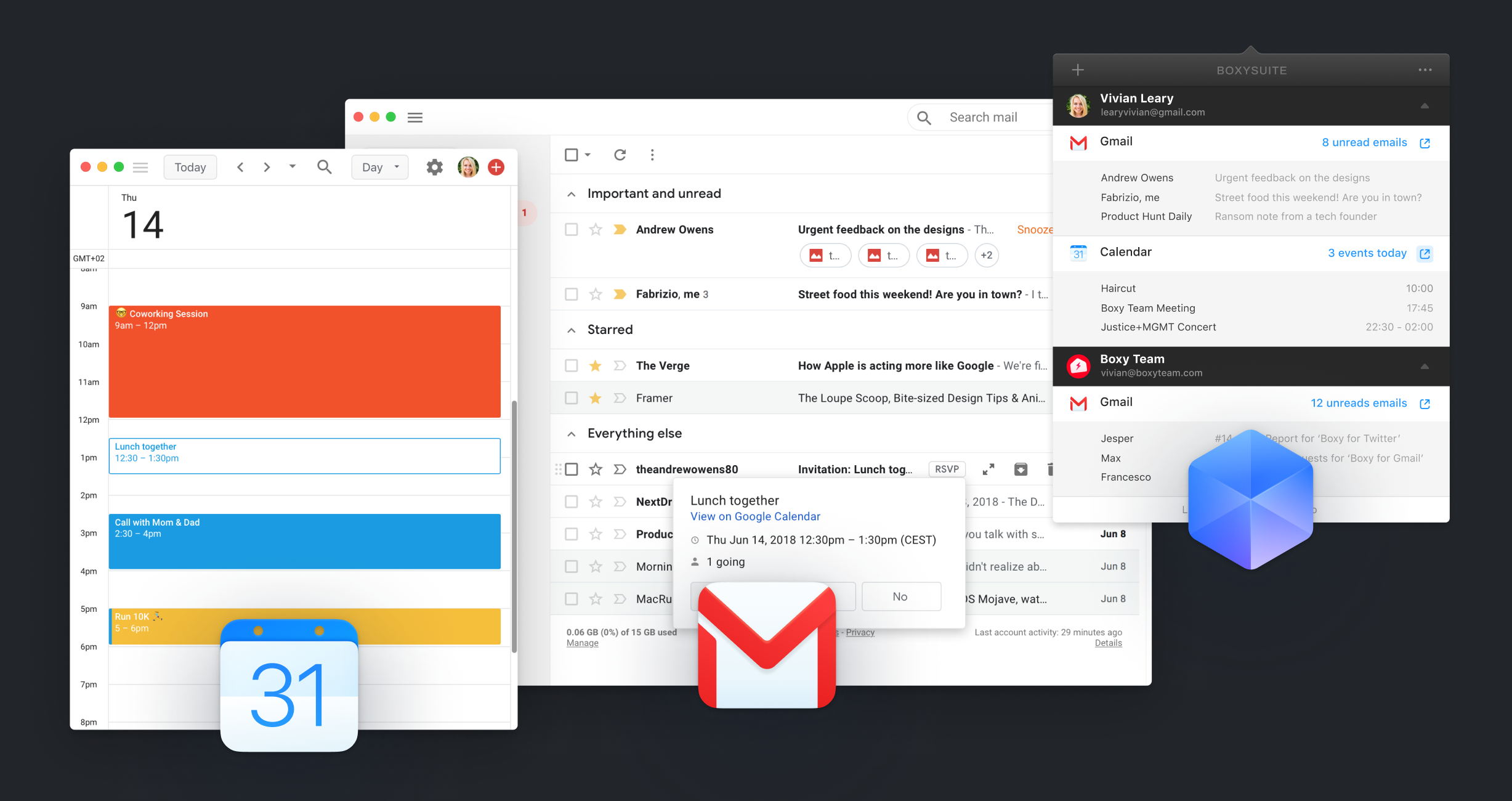
While building Boxy Suite and still being full-time employed, we slowly embraced our entrepreneurial attitude and realized just how much we love having complete ownership over what we build, and we felt increasingly confident about going full-time on this. So in late 2018, after many discussions, we decided to quit our jobs to go full time on Boxy Suite.
Quitting our jobs, especially in the Italian economy, has been the scariest decision of our lives. We even refused a small but interesting offer from an angel investor, since we’re committed to bootstrap Boxy Suite to profitability and we prefer to stay independent and build this with our own forces. It’s going to be tough but we’re really committed and excited about this venture.
We’re quite happy about how things are going: We have more than 700 paying subscribers, we’re averaging $6k MRR (calculated based on our yearly subscription fees), and we had a successful launch, earning $15k in gross revenues in the first 30 days.
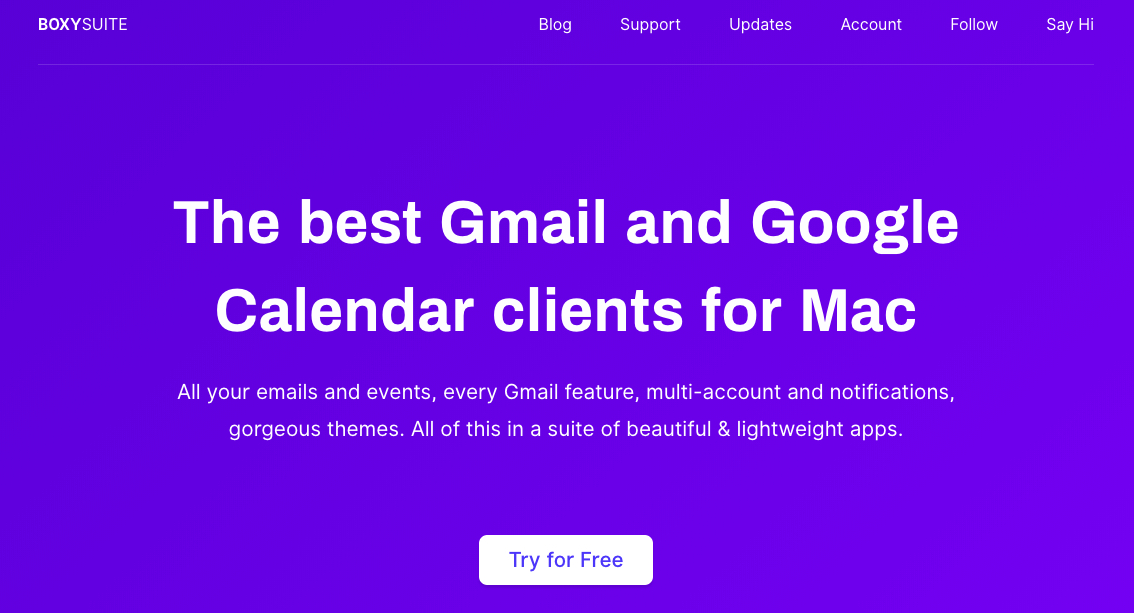
What motivated you to get started with Boxy Suite?
One of the key factors that made things click for us was the realization that many of the original Boxy users absolutely loved our product. For us, it was a passion project and we didn’t think there was much else we could do besides maintaining the app. After conducting interviews with a few selected users on Skype, we realized there was a huge opportunity to get to a much bigger audience by taking all we’ve learned with Boxy and applying it to Gmail and Google Calendar.
So we decided to build single-purpose, beautiful and powerful clients for the most popular email and calendar services in the world. Challenge accepted.
We were quite lucky with the timing since in 2018 Gmail got a nice (but controversial) redesign, and then Google sadly announced the demise of Inbox by Gmail. So we had thousands of customers about to look for something new, and the Gmail redesign helped us create a beautiful client for them.
We made this for people that constantly check Gmail and Google Calendar, and maybe run their businesses on these services. Many of them just use the browser, an unfocused environment where they’re bombarded by countless distractions; others use native clients that have nothing to do with Gmail and Google Calendar, which is a big turnoff if you love these services. There are other apps that wrap these services, but they look like super-charged browsers, while we’re trying to make something different with Boxy Suite, making Gmail and Calendar feel and behave like first-class macOS citizens.
We prepared to launch on Product Hunt as usual, but this time we also focused on transitioning our original Boxy active userbase—still more than 7k MAU—so we polled roughly 1,000 Boxy users to inform our roadmap and make rough estimates about market size and product fit.
Regarding pricing, we went from selling a single app for $6 (the old Boxy) to selling a productivity suite for $49/year or $149 one-time. Of course, we had no idea what kind of reaction we could have gotten and if the pricing was right, but we’ve been surprised by an overwhelmingly positive reaction. This showed us that Boxy Suite could really work as a business, and made us feel even more confident about our decision to go full-time.
What went into building the initial product? What are the biggest challenges you've faced and obstacles you've overcome?
Since we started working on “Boxy” in late 2015, Francesco and I actually never stopped working on side projects. Among them, there’s Sblack, a lightweight Slack client with Dark Mode which was downloaded more than 10k times in just a few weeks.
We started working on Boxy Suite as a side-project, working on it nights and weekends and nearly burning out in the process—which I don’t recommend doing since your health is much more important than any project. It’s so easy to feel like you can give 150% to work and still be fine in every other aspect of your life, but as I’ve learned first-hand, we all need to have a mindful and holistic approach to work and life as a whole. I think the concept of “work/life balance” is extremely restrictive and ambiguous, and doesn’t help make progress on these issues.
We had a few challenges during this time. We struggled a lot initially on staying focused on the right tasks while maintaining a realistic launch date. So we ended up deciding on a launch date multiple times and postponing it by a few months every time. We’ve learned that “passion project” doesn’t mean “let’s just do whatever we want, when we want it;” now we try to focus on high-level tasks first, being more pragmatic about our decisions, frequently organizing and prioritizing to-dos, and investing in the right tools to optimize our workflows. As indie makers, we had a tendency to not want to spend for tooling and “back-office”, but if you spend $100 or $200/month on the right tools, you’re freeing up time and mental energy to do get shit done, and that’s invaluable.
Technology-wise, we’ve always taken pride in not using Electron, which is a great technology but with well-known flaws. We opted instead to create and grow our own tech stack, which is based on native macOS web technologies. That’s why our apps are so small in size and feel more performant than Electron/Chrome-based wrappers.
As an extreme example of this, Sblack, the Slack client we mentioned above, just took a few days to make, and many people prefer it over Slack’s official client, and not just because we added a Dark Mode. Scrolling in our apps, for example, has that nice inertial feel and bouncing effect that you lose when you go with Chrome-based solutions.
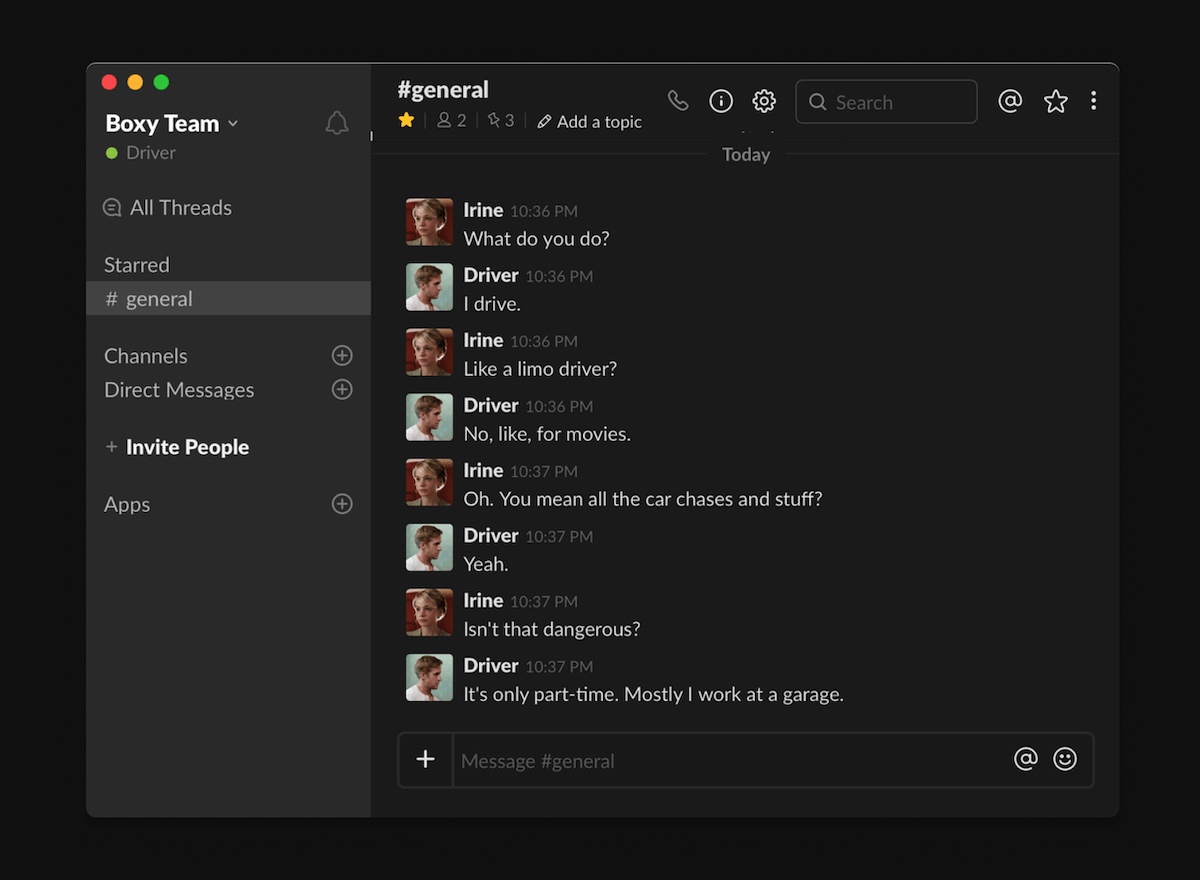
Of course, this approach has its own challenges. Chrome seems to be the new Internet Explorer, and many big players, obviously Google at the forefront, are heavily optimizing their apps for Chrome, so our Safari-based wrappers incur some Safari-specific issues that we have to fix in hackish ways.
Another challenge we faced is convincing people that these apps are not “just wrappers”, but that they actually make you more productive and there’s a lot of effort behind building this kind of software. Just to style the web apps to make them more compact, responsive, and macOS friendly, we wrote thousands of lines of code. Luckily, for every visitor that views Boxy Suite as something that is not worth the price, there are many more that understand its value and love the product. Here’s a message we received from an early adopter shortly after launching Boxy Suite, that really made us feel like we were onto something: “Just wanted to say you have no idea how happy this makes me—when Inbox was discontinued I was sad because Boxy was the best experience I’ve had with email in a long time. I’m so incredibly glad you’ve released Boxy Suite and loving it already!”
What are some tools that helped you along the way?
If I had to pick one single tool that helped us since the start and never let us down, that would be Dropbox Paper. I’m writing this very piece on Paper, our roadmap is here, our tasks are here, documentation, ideas, you name it. We keep some stuff elsewhere though; for instance, Notion has really great Markdown export, so we used it to write some blog posts, but Paper stays as our todo and documentation hub. They even introduced a Timeline feature recently, so it’s getting even better for makers and small teams.
Another one that maybe is not the kind of “tool” you’d expect on this list is Telegram. When we worked on the original Boxy, we mostly used Slack, which can be cumbersome and slow. We approached Telegram with just a single “Boxy Team” group where we write about “work,” keeping personal convos in the direct chat. We then added a “Boxy Team Stats” group where we receive notifications about key events that we want to keep monitored: sales, subscriptions, daily visitors on our website, daily subscribers count. We even received messages with what users write to us when they unsubscribe from Boxy Suite, which is amazing to feel the pulse of the situation product-wise. A game-changer was a recent addition, though: “Boxy Team Commits.” It’s a live stream of commits we do on our reports, complete with links to quickly jump in, even from mobile and comment on the commits themselves. This makes us even more efficient while keeping things asynchronous, and we don’t even need to tell each other if we’re working since it’s now self-evident in most cases.
Finally, I want to mention a couple of tools we really couldn’t live without: AirTable and Zapier. I’m mentioning them together because they integrate beautifully, and they let us automate and optimize many areas of our workflow. Our customer support is 100% running on these tools. Tickets are submitted on an AirTable form that even gets pre-filled with data from the apps, and Zapier polls new tickets from AirTable and sends us nice emails (complete with user avatar found via avatars.io), with the original user email as the “reply-to” address. It’s cheap and works like a charm (we recently wrote about it).
Honorable mention: I almost forgot to add Figma to the list, but that’s because I just take it for granted now. It’s a perfect design tool, fast and collaborative by design, and I can’t think of anything better for a small, remote team. That being said, I’m playing a lot with Framer lately, and it’s really impressive as a modern design tool, blurring the line between design and dev environments.
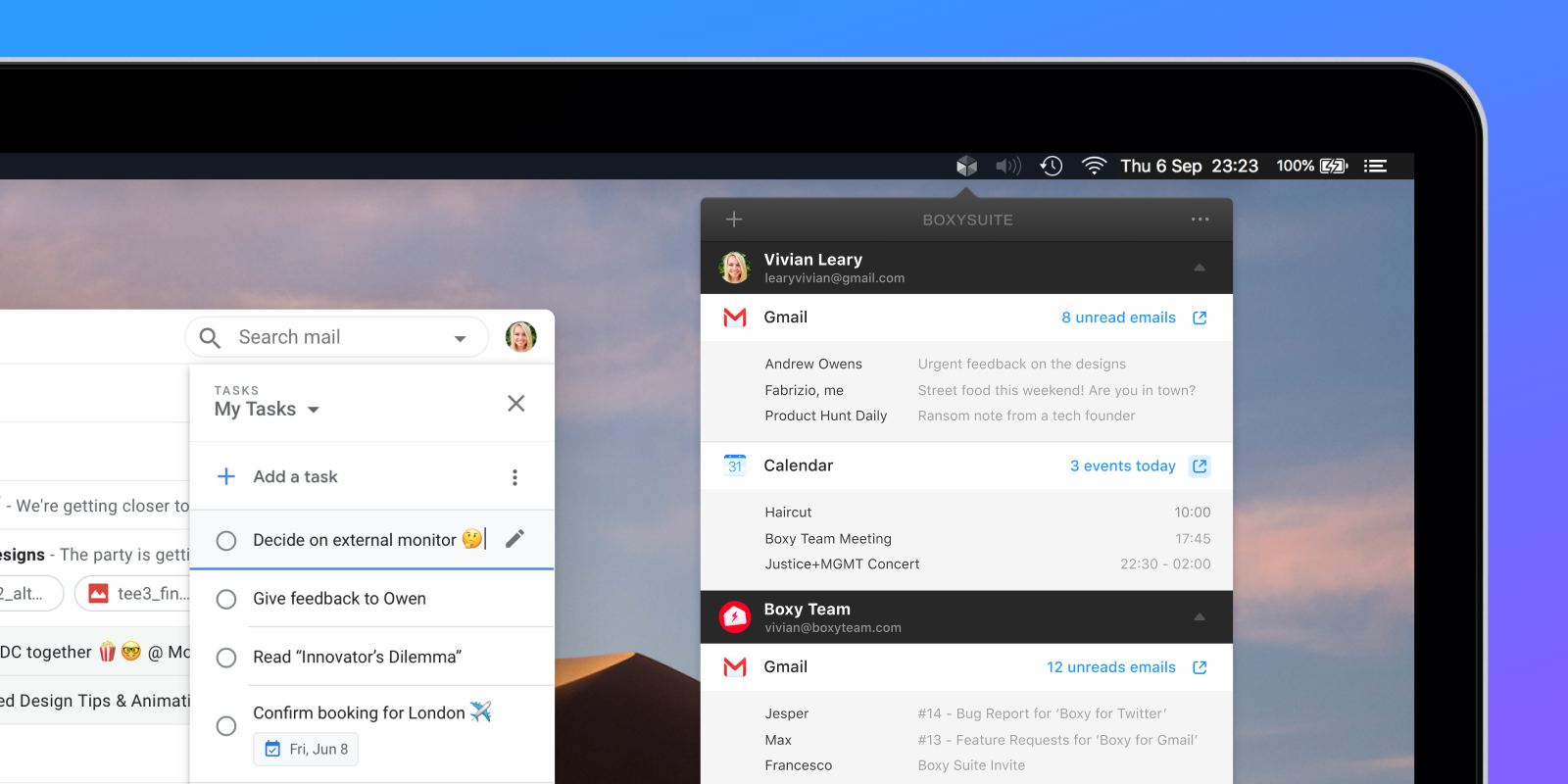
How have you attracted users and grown Boxy Suite?
I still remember how baffled we were by everything during the original launch of Boxy on Product Hunt in late 2015. At that time we had a growing an email list of a few thousand people interested in Boxy, and we ended up getting 1400+ upvotes on Product Hunt and incredible press coverage.
In the years following the initial launch we’ve grown our user base a lot, and now we send product updates to a newsletter with almost 20k subscribers. This email list has been an important asset to launch and grow Boxy Suite.
Even if we didn’t get many upvotes on Product Hunt this time around, PH brought 10k viewers to our website and surely helped us earn those $15k in the first 30 days, with zero marketing, very little homemade SEO, and basically no press coverage. For us, this meant one thing: The product works, and many people are finding value in it. There’s no better validation than people buying what you ship.
In hindsight, after investing so much on this product, it was a mistake to not focus more on getting press coverage. We moved too late (sending emails very close to the launch date) and didn’t follow-up enough with reporters. A few good articles would have helped the product reach more people and the site to rank faster on Google.
On the other end, Sblack got a lot of attention on Product Hunt and it drove a lot of traffic to Boxy Suite. This validated our idea that small but interesting side-side projects are still a good way to bring traffic to your main product.
What's your business model, and how have you grown your revenue?
I still remember the day after we launched the original Boxy in 2015. We woke up with $12k in sales as reported on iTunes Connect, which blew our mind. With every other product we’ve had since, we’ve charged from the beginning and made money with direct sales to customers.
With Boxy Suite, we made the important transition from one-off payments to subscriptions, and I it seems like the timing has been perfect. Customers are more and more used to subscriptions, and the reception has been great. On the other hand, we believe that for customers subscriptions don’t scale, and at some point it will be necessary to find some kind of tradeoff. Users can’t really pay tens of subscriptions for all the apps they want. Setapp, for example, is a great solution for Mac users, so the market is already evolving and we’ll follow these changes closely.
100% of the money we’re making comes from Boxy Suite sales. We started with a single $49/y plan, and then we added a $149 lifetime license, which was a great success during Black Friday, when both plans where discounted by 30%. We’re now about to add team licensing options, since we got many requests for it as well (exciting!).
As usual with product launches, we’ve seen a great revenue spike—$15k of gross revenues the first month— and then a decrease in sales, which stabilized around $6k MRR. We’re really happy about our choice of Paddle as a reseller: they've been incredibly helpful when preparing our checkout and in preparing to launch Boxy Suite successfully. They’re still supporting us and giving us useful resources to improve our monetization strategy.
We’re lucky to have fairly small costs. It’s great to be able to run a startup with affordable tools; this allows us to scale the product without worrying too much about rising costs, which is amazing. Here’s a gist:
- We serve downloads and app updates via Amazon S3 and this costs us about $10/m
- We run our servers on Heroku with add-ons for databases and email delivery—all in all we are spending around $50/m
- Another essential tool is Zapier, which we use to automate customer support, accounting, and other minor tasks—it costs $20/m
- We also have a couple of servers on Digital Ocean—one to host Mailtrain that we use to deliver our newsletters and one to support the old Boxy version—that cost us about $10/m
- We’re experimenting a little bit with Facebook Ads and similar growth strategies, so there are one-time payments of $40-50 every other month
What are your goals for the future?
Our goal is to reach $10k MRR. We prefer to keep it simple and have this one clear, simple goal to keep in sight. It’s not a vanity metric, but a number that we decided would represent profitability and peace of mind.
How are we trying to reach this goal? There are two fundamental parts in this process: Improving the products, which we finally have plenty of time to do, and finding new customers, which is even more critical and complex.
Even with more than a billion Gmail users around the world, reaching the right audience is not trivial. We have great competition and, truth be told, we’re absolute rookies for what concerns marketing and growth. Fortunately, our efforts are starting to pay off, and Boxy Suite is (very) slowly rising on Google for critical searches like “Gmail for Mac” or “Best Gmail client for Mac”, and the more it moves to the top, the better. We’re not betting everything on organic traffic though, so we’re working on some great partnerships, sponsorship, quality press coverage and attracting users via different channels, like our blog.
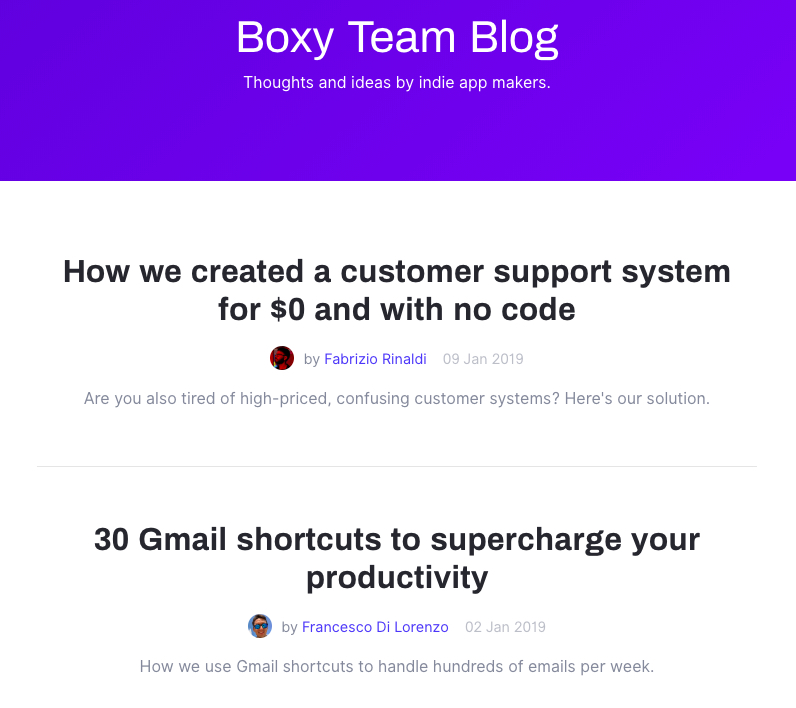
Interestingly enough, we have found that adding features and getting people excited about those is a great way to attract new customers. We are working on some amazing features that will set us apart from the competition and make Boxy Suite a must-have instead of a nice-to-have.
Another goal that is more philosophical and life-related, is that we want to work only because we want to, and leave plenty of time for relaxing, exploration, and personal growth. We’re the most productive when we have time to pursue different ideas, research, take time off and not stress about work. For instance, we’re recently started working in 1 or 2-week “sprints”, but the word sprint is not meant literally at all: It means that until we’ve tackled a high-level or massive task (like revamping our accounts management system) we won’t get too distracted by other things, and it will be our main focus until it’s done. This doesn’t mean that if I don’t work eight hours on this task I won’t feel accomplished. It means I know where to focus.
During sprints, it’s common for us to say “I’m going for a run now, I’ll work later” in the middle of the day, and generally we take a very laid-back approach to work, which is always asynchronous-first. A side effect of this approach is that I’m feeling way more focused and in the zone now, compared to when I worked in a company.
What's your advice for indie hackers who are just starting out?
I feel like we still have so much to learn that I’m not in the position to give advice to anyone, but looking back there are a few things we’ve uncovered that are worth sharing.
One piece of advice that comes to mind is to focus on product and not blindly adopt the “just ship it” approach that many people endorse these days. There are so many mediocre products launching, that aiming for product quality that goes beyond “good enough” already sets you apart from the competition. I believe that users can tell the difference when there’s some effort and care behind a product. The fact that many cool products launched on Product Hunt just a few months ago are now dead is telling. Ironically, I just thought, “Hey, I should make a Product Hunt Graveyard or something” so I checked and of course this exact thing launched on Product Hunt, but guess what? It looks like it’s dead.
Next piece of advice: Always think long-term, even when working on a small product. Is this a small weekend project? Maybe it can go viral and bring a lot of users, I should probably ask them to subscribe to my newsletter. Is this a more ambitious product that could be used by a team? Maybe I should have a form that people interested in team pricing can fill from day one. Ask yourself questions like these early on, and you’ll live with fewer regrets.
More makers could benefit from trying to think long-term in general: How will I reach many users? Is this actually useful, or does it just look cool on Product Hunt and I’m doing it for personal branding? Not that there’s anything wrong with launching things to grow your Twitter presence, but I don’t think it’s a great long-term strategy if you ultimately want your products to have an impact.
Finally, I want to stress that in the months prior to launching Boxy Suite, I sometimes failed to follow my own advice and, after coming back from work at 7pm and maybe only having stopped for gym and dinner, I put in another three or four hours to work on Boxy Suite even if I was tired already. This slowly took a toll on the quality of my sleep and overall well-being, and after finally launching the Suite, I didn’t really look like myself. So would I do this all over again? Probably, but I would stop myself from compromising my health in any way, and setting a bad example for other people—which is why in many companies these unhealthy behaviors spread like diseases. There’s finally a general trend towards having a healthier approach to work, and we’re happy to play our small role in promoting it.
Where can we go to learn more?
The best way to stay up-to-date on our products is to subscribe to our newsletter, where we only send emails about product launches and major updates.
We’re also very active on Twitter: I’m @linuz90, and Francesco is @frankdilo. You can also follow our Boxy Team account where we post product-related tweets and launches.
